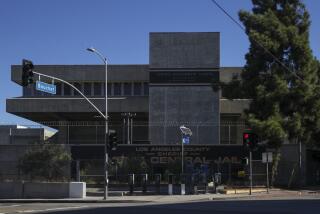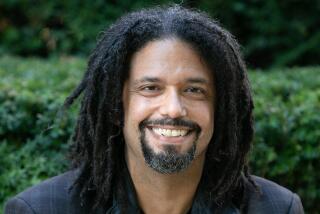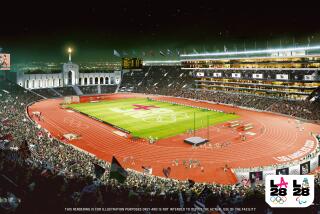Exact Nature of Coliseum Weld Defects Sought
- Share via
Members of the Los Angeles Coliseum Commission on Wednesday directed engineering consultants to further examine the stadium’s new press box to verify the nature of weld defects identified by recent testing.
The commissioners voted unanimously to authorize the collection and laboratory analysis of physical samples of some of the welds. The expanded testing was recommended in a report presented to the commission Wednesday by the structural engineering firm of Nabih Youssef & Associates, which designed and oversaw the construction last year.
An engineer from the Youssef firm, Brent Nuttall, told commission members that based on the data he has reviewed, he continues to believe the structure is safe. Nuttall’s firm has yet to certify that the press box was built in conformance with the design, preventing the city’s issuance of permanent occupancy permit.
The commission directed John A. Martin Jr., a structural engineer who reviewed an advance draft of the Youssef firm’s report, to lead the ongoing examination of the press box. Based on his review of the Youssef report and the recent testing data, Martin has termed the structure safe but also recommended that defects confirmed by the upcoming round of testing be repaired “or mitigated.”
In response to a question posed at Wednesday’s commission meeting by County Supervisor Zev Yaroslavsky, Martin said he thinks the press box would perform adequately in the event of a magnitude 7.2 earthquake. Martin said before and during the meeting that his examination of the press box has consisted of reviewing the structural drawings and reading Youssef’s report and the recent test results.
During his two-week effort, Martin said he did not look at any inspection reports from the original construction--some of which reported instances of so-called delayed cracking and lack of compliance with the project’s welding specifications.
The recent testing was undertaken in response to a May 5 Times article reporting numerous welding problems experienced during construction of the press box last year. The testing involved examining some of the welded connections with ultrasound. Flaws were found in 12 of 47, or 26%, of the welds that were tested.
Nuttall did not attempt to characterize what those defects are at Wednesday’s meeting, other than to repeat the conclusion of his firm that the flaws are not cracks.
But Nuttall and Martin acknowledged in interviews Wednesday that, until the physical samples, or cores of the welds, are harvested, they will not know with certainty whether some of the abnormalities are or are not cracks.
“That’s what we’re going to find out,” Martin said.
Asked if he is confident that the abnormalities are not cracks, Martin said: “I’m pretty confident. But not confident enough not to [collect the core samples].”
If the new round of testing confirms the existence of defects, be they cracks or another type of flaw, Martin said “there are a number of ways” to effect repairs. The repairs could be completed, he said, “very quickly.”
Martin said afterward that he also intends to use the cores that are taken to test whether the weld material is brittle, or less resistant to fracture from an earthquake or other stress.
Robert G. Milliron, a veteran welding engineer who reviewed the Youssef firm’s report and the newly collected ultrasound testing data at the request of The Times, said Wednesday that he believes some of the identified flaws could be cracks.
“The nondestructive-testing reports indicated linear-type discontinuities” that are consistent with cracks, Milliron said.
He noted the test data shows that one weld, at one of the structure’s crucial “wing plates,” has an abnormality that is 8 1/4 inches long and three-quarters of an inch wide. “At the very least,” Milliron said, “it’s lack of fusion [between the weld material and the steel]. And it very easily could be a crack.” A crack is regarded as the worst type of weld defect, followed by incomplete fusion.
Whether they are cracks or some other type of defect, Milliron said, the locations of the identified abnormalities make them “highly detrimental to the structure.” Milliron, who for 19 years was a welding and testing engineer for the state Department of Water Resources, now operates a consulting business.
Nuttall, asked to further explain his preliminary conclusion that the flaws are not cracks, said during a break in the meeting that he is relying on testing specialists, who told him the abnormalities are more circular in shape, as opposed to flat and straight. He added that he will withhold final judgment until the cores are examined.
In that regard, the commission ordered that the cores be collected by a specialist or firm with no previous involvement in the Coliseum construction or the recent testing. The move appeared to stop or reduce the ongoing role taken by Smith-Emery Co., the firm that inspected the original work and conducted much of the recent ultrasound testing.
The president of Smith-Emery, James E. Partridge, had told the commission that his firm could collect and analyze the cores within three days. In addition to using ultrasound, Partridge said that during the recent testing his firm opened one connection to see whether an abnormality was a crack. Partridge said his inspectors found the flaw to be an inclusion of slag.
The connection “will have to be refilled” with sound weld material, Partridge said.
Yaroslavsky, while stressing that he did not wish to impugn Smith-Emery, said the retention of of an independent firm is imperative for the upcoming collection of weld corings.
At the urging of Los Angeles City Councilman Nate Holden, the commission also assigned Martin to review the adequacy of three vertical box columns that The Times reported last week had been rejected by inspectors but later accepted without a recommended repair being made. The press box hangs over hundreds of spectator seats and is supported, in part, by a line of seven box columns and roof trusses.
The Coliseum Commission is composed of nine members, three from the County Board of Supervisors, three from the Los Angeles City Council and three from the state.
More to Read
Sign up for Essential California
The most important California stories and recommendations in your inbox every morning.
You may occasionally receive promotional content from the Los Angeles Times.














